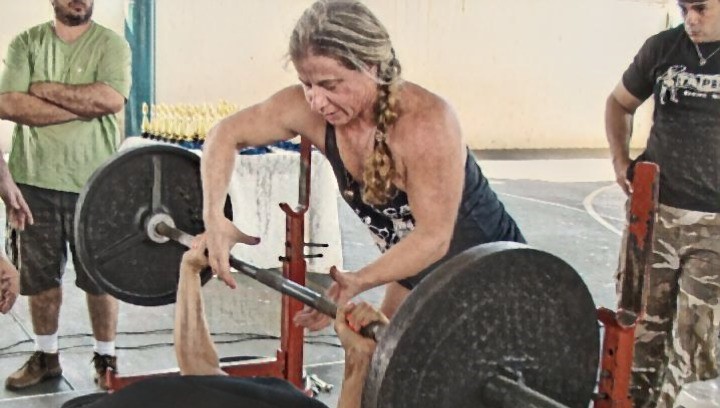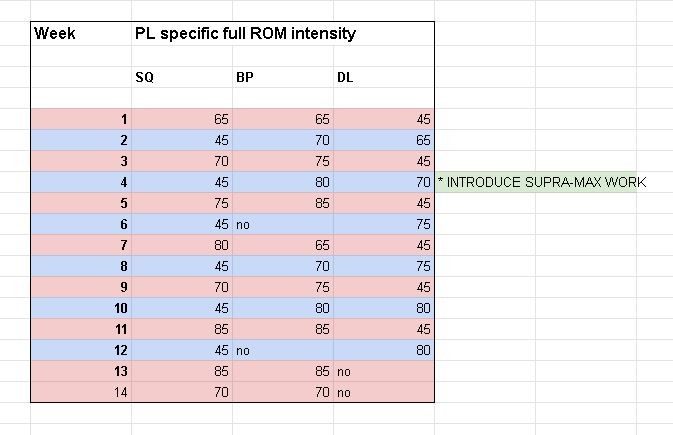
I knew Dave for a couple of years already and, initially, he trained with me about three or four days a week, with no other purpose other than to learn lifting technique. He is a ~40 years old, 6ft tall, ~240lbs physical educator and works as a coach, with a focus on strength and conditioning. His athletic origins are the martial arts, something many of my best athletes shared. He had a good deadlift, a solid bench press but because of the training facilities he worked at (and trained), his squat was not that great. By technique development alone he increased his squat maximum by 57% in one year. For comparison purposes, he increased his bench press by 16% and his deadlift by less than 4% in the same period. That was the first time he trained the powerlifts, specifically, and prepared to compete in powerlifting.
A few years later Dave started to feel hip discomfort and his MRI showed a couple of cysts in the acetabulum on both sides. That made us all nervous for a while because hip cysts can be a lot of things and some of them are not good news. We found a few movements he could do without feeling discomfort but squats were out of the menu for the moment.
I can’t say Dave adopted a problem-solving attitude towards the injury: he used the prescribed anti-inflammatories and eventually, just as it had appeared, the pain disappeared out of the blue. I have no idea what an MRI would show because there he made none.
Dave asked me to design a program for him as a "comeback" to lifting and he planned to participate in a small full power meet just to have a timed goal and measurable results.
Here was the new problem: Dave was now working with a new schedule and clients and his time and training environment constraints created a programming challenge.
This is a coaching log and not a conceptual column article so I am not going to explain periodization, structured cycles or programming strategy. Neither will I explain my approach to intensity prescription, where I combine the nominal percentage with perceived effort based on reps-on-reserve. It’s important to emphasize, though, that my approach defines that the smallest periodized unit (I don’t care what you call it) can have any length of time from five to fourteen days. The choice depends less on my strategy and more on the athlete’s (client’s) availability.
Dave had very little flexibility. This is what he presented me with:
- A life strictly organized around the 7-day week
- Two consecutive days when he had access to a well-equipped Crossfit facility (that included friends who could spot and help).
- Two days where he only had access to a chain gym similar to the American Planet Fitness chain, with no barbells but good machines and dumbbells
- A possible weekend day with access to a fully equipped powerlifting home gym that belonged to a friend
He had around 1.5h for each session.
The minimal unit ceased to be a problem (because problems are issues with possible solutions): it would be a 7-day cycle, block, whatever.
I don’t like to work with “maybes” and “possible” things. Sometimes it is impossible to avoid this type of uncertainty, as you will see in other cases where I had to design two routine structures for the two possible work schedules that the athlete had. In Dave’s case, I crossed out the “possible” weekend day.
Since his barbell days were consecutive, I couldn’t use one for the squat and one for the deadlift. I believe it’s counter-productive or outright harmful, in a worst-case scenario. Dave felt no pain on the squat after our first adaptive months with very low intensity but it’s a coach’s responsibility to not take unnecessary risks.
Given his time constraint, I prescribed a very short pre-activation/warm-up sequence and the conditioning work was something he would have to squeeze into his work schedule. I didn’t think that would be a problem because he was also a striking coach and I assumed he could get some decent conditioning working with his people.
Here is what I came up with: I adopted a split in which I alternated squat and deadlift strength days/dynamic days weekly but would perform both lifts on the same day. The bench press and other barbell work, especially overheads, were done on the second barbell-day.
That created a structure in which the strength/static stimulus and the dynamic work for the squat and the deadlift were repeated every 14 days. Red is squat, blue is the deadlift.
The “bodybuilding” days were divided into upper and lower limbs.
This is all for today. Next week I will explain each type of routine and how Dave responded to the program.











